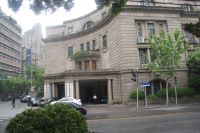
From Hong Kong (a capitalist enclave in the People’s Republic of China) we took a 21 hour train ride to Shanghai, which has been reclaiming its pre- revolutionary title as the center of capitalism (and finance) in China. I think of it, not always positively, as New York.
One of the original treaty ports opened to foreign settlement in 1842, it gradually became an enclave with its own self government—in fact, two governments. One, that controlled the area we’re in now, was once the famed “International Settlement,” formed by the union of the British and American concessions in the 1860s. Administered by foreigners, it was really a quasi-independent city, with its own officials (elected by a minority, which did not include Chinese until the 1920s), its own police (supplemented when needed by forces from the foreign navies here), its own stamps (at least until 1896; the stamps featured the dragon, an otherwise imperial symbol), and courts which administered foreign laws. There was a US Court for China, for example.
Because of extraterritoriality, the right to be in this protected Settlement (the French, as was their wont, refused to join, and had the French Concession, which was more known for gambling and gangs; it was right next to us, along the Whangpu, the area known as the Bund), safe from the vicissitudes of civil war (the disintegration of the Chinese empire lasted almost 100 years, and included a 19th century quasi-Christian uprising called the Taiping rebellion that lasted nearly 20 years, and left millions dead, and swelled the population of Shanghai with refugees).
In the early 20th century, Shanghai became the hub of especially British, and later Japanese, enterprises in central China, as the port connecting the Yangtze interior to the rest of the world. Hence, along the Bund were located the major banks and hotels and clubs that recreated the lifestyle of countries thousands of miles away. We’re just behind the Bund, that 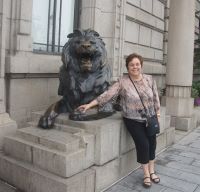
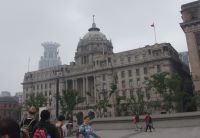 wonderful façade of 1920s and 1930s buildings that you might have seen in Empire of the Sun. The former Hong Kong and Shanghai Bank, just down the street from us, dominates the Bund—its British lions restored in front guard the entrance to an interior that I remarked to Ruth Ann, “I’ve seen churches that aren’t this nice,” with marbled floors and columns, and murals recently uncovered on the ceiling depicting stylized cities of the Western world.
wonderful façade of 1920s and 1930s buildings that you might have seen in Empire of the Sun. The former Hong Kong and Shanghai Bank, just down the street from us, dominates the Bund—its British lions restored in front guard the entrance to an interior that I remarked to Ruth Ann, “I’ve seen churches that aren’t this nice,” with marbled floors and columns, and murals recently uncovered on the ceiling depicting stylized cities of the Western world.
Because of its association with capitalism under the Nationalists, Shanghai suffered for a long time after 1949. Many of its industrialists fled, either to Taiwan or Hong Kong, to help jump start those “tigers,” but Shanghai languished until the early 1990s, when former political officials from Shanghai—Zhu Rong-ji and others—moved into high offices in Beijing, and the city more than came alive economically. Always populous, it now has 23 million inhabitants. Always crowded, it has (since my first visit here in 1990, and with a great assist from the Shanghai Expo) found ways to move crowds (infrastructure is one of the major contrasts between China and India; on our over 800 mile ride from Hong Kong to Shanghai, we were paralleled by new highways) such as subways, expressways (some of which destroyed the old colonial homes; I’ve met Tess Johnston, who has compiled “Lost Shanghai,” and other books detailing the colonial architecture. She and her photographer were taking pictures of the buildings as the bulldozers were tearing them down), and double decking. One of the most crowded streets was the Bund, which had 11 lanes of traffic and needed 20. That was torn up and an underground tunnel put in. Amazing changes.
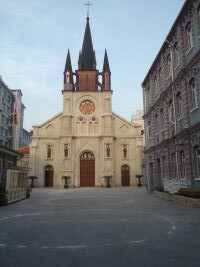 I love the old colonial architecture of the Bund (so called Puxi, the west side of the Whangpu river), and the Chinese have made serious efforts to preserve the “heritage” of the colonial past. The buildings in this area are signed with the period, former use, and architectural style. Many are art deco, dating from the late 20s, or early 30s, such as the Sassoon House, lavishly redone (3 years of renovation) by the
I love the old colonial architecture of the Bund (so called Puxi, the west side of the Whangpu river), and the Chinese have made serious efforts to preserve the “heritage” of the colonial past. The buildings in this area are signed with the period, former use, and architectural style. Many are art deco, dating from the late 20s, or early 30s, such as the Sassoon House, lavishly redone (3 years of renovation) by the  Fairmont, and its 1906 partner, the former Palace Hotel, now the Swatch Art Palace Hotel (naming rights?). At least one has been restored to its former use, as the headquarters of AIA. Cornelius V. Starr, the founder of the insurance company, had a building on the Bund, and maintained good relations with the Chinese government after 1949, and returned here in the
Fairmont, and its 1906 partner, the former Palace Hotel, now the Swatch Art Palace Hotel (naming rights?). At least one has been restored to its former use, as the headquarters of AIA. Cornelius V. Starr, the founder of the insurance company, had a building on the Bund, and maintained good relations with the Chinese government after 1949, and returned here in the 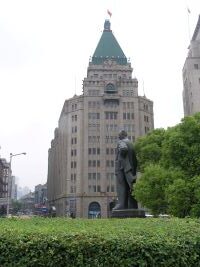
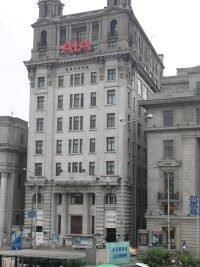 late 1990s. Not many people know (but I do) that the “AIA” building was owned by the North China Daily News, a British newspaper devoted to preserving the colonial way of life, but as I’ve said, I love irony (the most ironic location, perhaps, was when I came in 1990. There were few places where foreigners could buy things, the so- called “Friendship Stores,” which used special money—foreign exchange certificates; the biggest was in Shanghai, on the grounds of the former British Consulate).
late 1990s. Not many people know (but I do) that the “AIA” building was owned by the North China Daily News, a British newspaper devoted to preserving the colonial way of life, but as I’ve said, I love irony (the most ironic location, perhaps, was when I came in 1990. There were few places where foreigners could buy things, the so- called “Friendship Stores,” which used special money—foreign exchange certificates; the biggest was in Shanghai, on the grounds of the former British Consulate).
If you’re a foreigner walking along the Bund, you’re likely to take pictures of yourself facing the Shanghai that people in the 30s, who had spent months at sea, witnessed on their arrival.
If you’re Chinese (or young Americans, like IWU students) you’re likely to 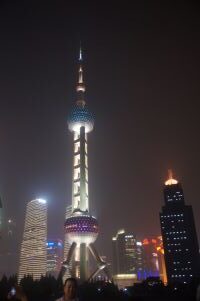 be drawn to Pudong, the East side of the Whangpu River, which is the symbol of the new, new, newest China. The Pearl TV tower dominates this new town, which I visited when it was a gleam in a developer’s eye (in 1994 or so). It was rice fields and construction gear, and we went to a construction hut where there was a plan for the financial capital of China, with 3 million people, a major new airport connected to the city by a maglev train, the tallest buildings in the world; I thought, “Fat chance.” If you’ve seen the toilets, you’ll wonder what chance the Chinese had of creating this model city. 12 years later, on the way to Pudong airport, driving past this city of 3 million people to the major new airport watching the maglev train speed by the tallest buildings in the world (including one shaped like a bottle opener), I ate crow before that group of students, warning them not to doubt China’s ability to do whatever China sets out to do.
be drawn to Pudong, the East side of the Whangpu River, which is the symbol of the new, new, newest China. The Pearl TV tower dominates this new town, which I visited when it was a gleam in a developer’s eye (in 1994 or so). It was rice fields and construction gear, and we went to a construction hut where there was a plan for the financial capital of China, with 3 million people, a major new airport connected to the city by a maglev train, the tallest buildings in the world; I thought, “Fat chance.” If you’ve seen the toilets, you’ll wonder what chance the Chinese had of creating this model city. 12 years later, on the way to Pudong airport, driving past this city of 3 million people to the major new airport watching the maglev train speed by the tallest buildings in the world (including one shaped like a bottle opener), I ate crow before that group of students, warning them not to doubt China’s ability to do whatever China sets out to do.
We got in around noon and had the day free, and, as you can tell, I enjoyed wandering aimlessly in and out of the 1920s and 1930s (the students think that was my youth), occasionally stopping for 2012. We do our tour tomorrow.